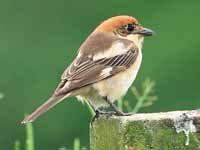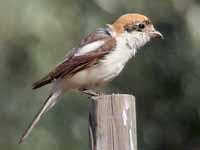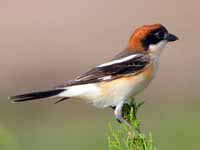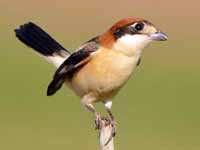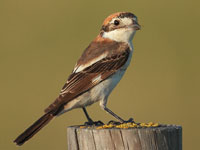The shrike families are: Campephagidae, Laniidae, Malaconotidae, Prionopidae.
Shrikes have a hooked beak that enables them to catch small animals and insects. They often impale their meals on thorns which explains the derivation of their name from the Latin word for butcher. They sit upright on the tops of shrubs and other conspicuous perches to spot their prey and also to advertise their presence to competitors. Their coloring is drab. Most shrikes are located in Africa, Europe, and Asia. They are closely related to the bushshrikes and helmetshrikes,. The live in relatively open spaces.
Genus Corvinella
Shrike,_Magpie also African Long-tailed Shrike Corvinella melanoleuca Found: Africa
The Magpie Shrike has mainly black plumage with white patches and markings. It is alternatively placed as the sole member of genus Urolestes.
Image by: 1, 6) Dick Daniels - Kruger National Park, Sourh Africa 2) Sandy Cole - Kruger 3) Nik_Borrow 4, 5) Dick - Tanzania 7) Tarique_Sani - Tanzania 8) Tude_e_Joao - Botswana

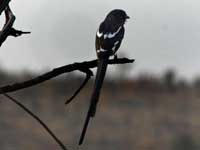
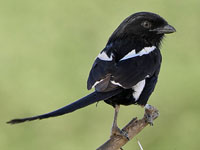
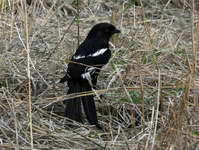

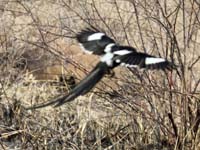

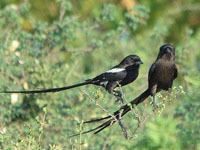
Shrike,_Yellow-billed Corvinella corvina Found: Africa
The Yellow-billed Shrike has mottled brown upperparts; streaked by underparts; brown eye-mask; yellow bill.
Image by: 1) Tom Haslam - Senegal 2) JV Verde - The Gambia 3) Charles Sharp - Gambia 4) Nik_Borrow 5) Gisela Braun 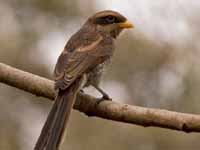

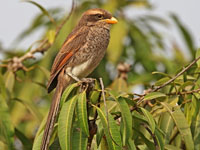
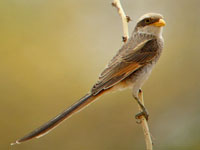
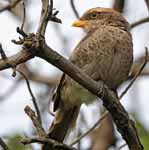
Genus Eurocephalus
Shrike,_Northern White-crowned also White-rumped Shrike Eurocephalus rueppelli Found: Africa
The Northern White-crowned Shirke has dark brown upperparts; black nape, eye-line; white crown, throat, underparts.
Image by: 1, 2) Carol Foil - Buffalo Spring Reserve,
Kenya 3) Dick Daniels - San Diego Zoo 4) Nik_Borrow - Tanzania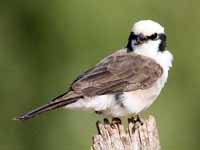
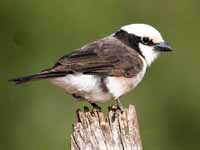


Shrike,_Southern_White-crowned Eurocephalus anguitimens Found: Africa
The Southern White-crowned shirke has ashy brown upperparts; white crown, throat, breast; pale ashy-brown belly, vent.
Image by: 1) Frank Vassen 2) Alistair Rae -
Namibia 3, 4) Derek_Keats - South Africa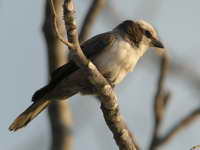

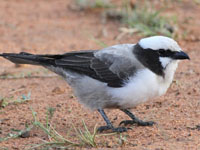

Genus Lanius
These are the "true" or "typical" shrikes. Some are term fiscals, derived from an African word for "hangman", because they hand their prey on thorns for storage. Most of these shrikes have insects as their main prey, but some of the larger shrikes eat small birds, reptiles, and mammals.
Fiscal,_Gray-backed Lanius excubitoroides Found: Africa
The Gray-backed Fiscal has a gray crown, nape, mantle; black mask, wings; white crown underparts.
Image by: 1) Darren Bellerby - Kenya 2) Nik Borrow - Uganda 3) Steve Garvie - Kenya 4) Mu Tong 5) Dick Daniels - Lake Naivasha, Kenya
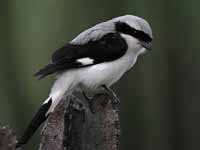
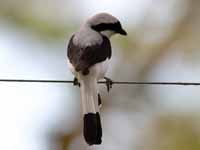

Fiscal,_Long-tailed Lanius cabanisi Found: Kenya, Tanzania
The Long-tailed Fiscal has black upperparts with gray on back; no white on scapulars; black tail; white underparts; long tail.
Similar to: Northern Fiscal. Northern Fiscal has white on scapulars; Long-tailed Fiscal has no white on upperparts.
Image by: 1) Frederic Salein - Tanzania 2) Carol Foil 3) Dave Curtis 4, 5) Dick Daniels - Nairobi National Park, KenyaSimilar to: Northern Fiscal. Northern Fiscal has white on scapulars; Long-tailed Fiscal has no white on upperparts.
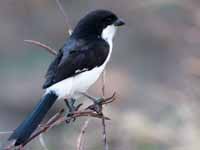
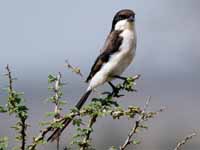
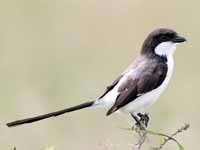


Fiscal,_Northern Lanius humeralis Found: Africa
The Northern Fiscal
has mainly black upperparts with a white V formed by the scapulars; black head; white underparts.
The Northern Fiscal was previously combined with the Southern Fiscal to form the Common Fiscal. The two species can be mutually found in Angola, Tanzania, and Zambia. Northern Fiscal can also be found north of these countires and Southern Fiscal can also be found south of these countries. Where the species overlap, DNA analysis can be used for differentiation.
Similar to: Long-tailed Fiscal. Northern Fiscal has white on scapulars; Long-tailed Fiscal has no white on upperparts.
Image by: 1) Joseph Mochoge - Kenya 2) Lip Kee Yap - Kenya 3) Jerry Friedman - KenyaThe Northern Fiscal was previously combined with the Southern Fiscal to form the Common Fiscal. The two species can be mutually found in Angola, Tanzania, and Zambia. Northern Fiscal can also be found north of these countires and Southern Fiscal can also be found south of these countries. Where the species overlap, DNA analysis can be used for differentiation.
Similar to: Long-tailed Fiscal. Northern Fiscal has white on scapulars; Long-tailed Fiscal has no white on upperparts.
4, 5) Dick Daniels - Hell’s Gate National Park, Kenya 6) Dick - Nairobi National Park, Kenya


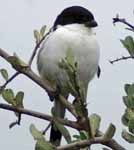



Fiscal,_Sao Tome also Newton's Fiscal Lanius newtoni Found: São Tomé and Príncip (west coast of central Africa)
The Sao Tome Fiscal has black upperparts with white wing patch; yellowish underparts. It does not have a white supercilium.
Image by: 1) Henrik Gronvold 2) Klaus Ewald1) Bottom: Sao Tome Fiscal 2) Top: Uhehe Fiscal (Lanius (collaris) marwitzi)


Fiscal,_Somali Lanius somalicus Found: Ethiopia, Kenya, Somalia
The Somali Fisca lhas black head, nape, bill; black wings with white-tipped secondaries; gray mantle; white underparts.
Similar to: Taiti Fiscal. Somali Fiscal has white-tipped secondaries, Taiti Fiscal does not.
Image by: 1) Dick Daniels - specimen in Nairobi National Museum, Kenya 2) Steve Garvie - Rift Valley, Kenya 3) Steve Rooke - EthiopiaSimilar to: Taiti Fiscal. Somali Fiscal has white-tipped secondaries, Taiti Fiscal does not.
1) Immaturre molting to adult
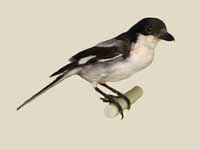
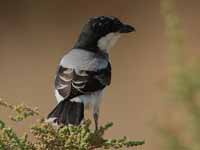

Fiscal,_Southern Lanius collaris Found: Africa
The Southern Fiscal
has mainly black upperparts with a white V formed by the scapulars; black head; white underparts.
The Southern Fiscal was previously combined with the Northern Fiscal to form the Common Fiscal. The two species can be mutually found in Angola, Tanzania, and Zambia. Northern Fiscal can also be found north of these countires and Southern Fiscal can also be found south of these countries. Where the species overlap, DNA analysis can be used for differentiation..
Image by: 1, 3) Dick Daniels - Johannesburg, South Africa 2) Derek Keats - South Africa 4) Kevin O'Grady 5) Cristiano Crolle - Wilderness, South Africa The Southern Fiscal was previously combined with the Northern Fiscal to form the Common Fiscal. The two species can be mutually found in Angola, Tanzania, and Zambia. Northern Fiscal can also be found north of these countires and Southern Fiscal can also be found south of these countries. Where the species overlap, DNA analysis can be used for differentiation..
1) Juvenile

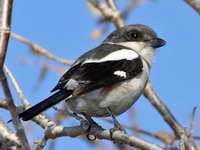

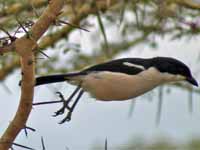
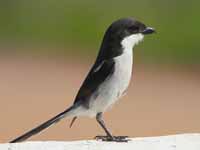
Fiscal,_Taita Lanius dorsalis Found: Ethiopia, Kenya, Somalia, South Sudan, Tanzania
The Taita Fiscal has black head, nape, bill, wings; gray mantle; white underparts.
Similar to: Somali Fiscal. Somali Fiscal has white-tipped secondaries, Taiti Fiscal does not.
Image by: 1, 4) Steve Garvie - Kenya 2) Dick Daniels - specimen in Nairobi National Museum, Kenya 3) Tarique Sani - Tanzania 5) Nik_Borrow - TanzaniaSimilar to: Somali Fiscal. Somali Fiscal has white-tipped secondaries, Taiti Fiscal does not.
1) Juvenile
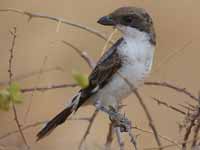
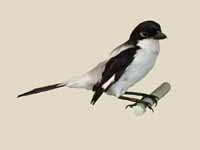
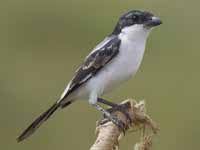
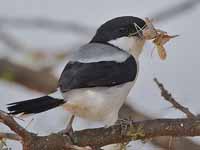
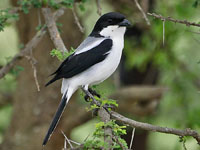
Fiscal,_Uhehe Lanius (collaris) marwitzi Found: Tanzania
The Uhehe Fiscal has black upperparts with white wing patch; white supercilium. Also consider a subspecies of the Southern Fiscal.
Image by: 1) Henrik Gronvold 1) Top: Uhehe Fiscal (Lanius (collaris) marwitzi) 2) Bottom: Sao Tome Fiscal

Shrike,_Bay-backed Lanius vittatus Found: south Asia
The Bay-backed Shrike has maroon-brown upperparts; gray crown, nape; black mask; whitish underparts with buff flanks.
Image by: 1, 2) JM Garg - India 3) Tarique Sani - India 4) Davidvraju - India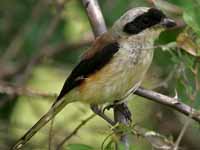
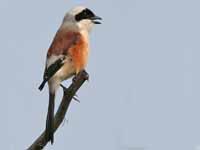
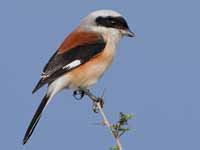
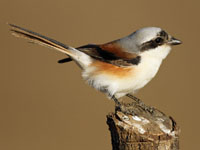
Shrike,_Brown Lanius cristatus Found: Asia, Africa
The Brown Shrike has brown upperparts; black mask; light underparts; buff flanks.
Image by: 1) Sergey Pisarevskiy - western Siberia 2) Vijay Ismavel
3) Charlie Westerinen - Thailand 4) K C Hung 5, 6) Lin_Sun_Fong - Taiwan 7) JJ_Harrison1 - 3) Female 4 - 7) Male
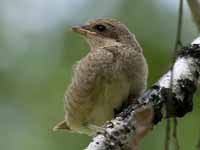
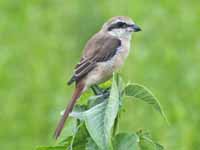
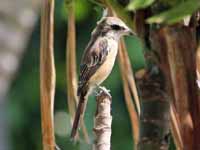
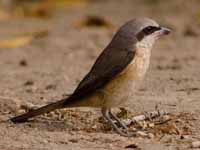
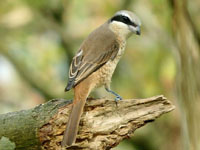
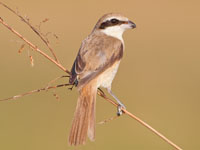

Shrike,_Bull-headed Lanius bucephalus Found: Asia
The male Bull-headed Shrike has a brown crown; white supercilium; black mask; dark wings with white patch. Female similar but duller; brown mask; no white wing patch.
Image by: 1, 2) Hiyashi Haka 3, 4, 5) Alpsdake 6) Paul 1, 2, 3) Female 4, 5, 6) Male
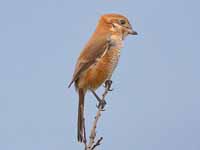
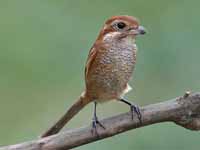
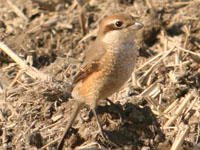
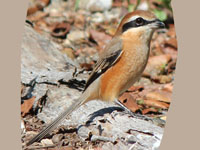
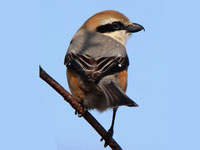

Shrike,_Burmese Lanius collurioides Found: southeast Asia
The Burmese Shrike has gray crown, nape; reddish brown upperparts; white underparts; black mask. Male has white wing patch.
Image by: 1) Sergey Yeliseev 2) Wayne Hodgkinson - Vietnam 3) Jason_Thompson - Thailand 4) Mike_Rose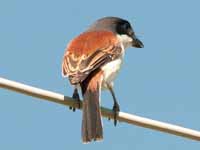

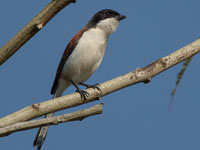

Shrike,_Chinese Gray Lanius sphenocercus Asia
The Chinese Gray Shrike has gray upperparts; black mask, white underparts. A large shrike.
Image by: 1) Blake Matheson - China 2, 3) Hiyashi_Haka
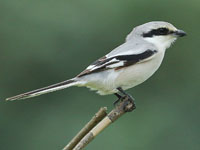
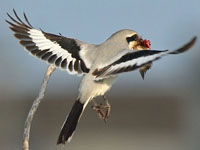
Shrike,_Emin's Lanius gubernator Found: dry areas in Africa
Image by: 1) Mike and Helen Cox 2) Nigel Voaden - Cameroon


Shrike,_Gray-backed Lanius tephronotus Found: southeast Asia
The Gray-backed Shrike has gray upperparts; black mask; yellowish flanks; long tail.
Image by: 1) Lip Kee - Thailand 2, 3) Vijay Ismavel 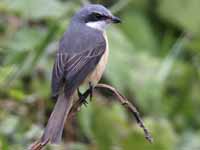
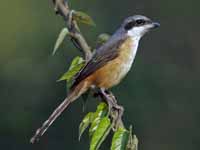
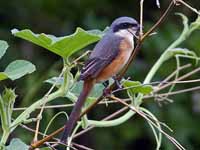
Shrike,_Gray-capped also Mountain Shrike Lanius validirostris Found: Phiippines
The Gray-capped Shrike has gray upperparts; white underparts. It is rare due to habit loss.
Image by: 1) Chito
Shrike,_Isabelline also Rufous-tailed Shrike Lanius isabellinus Found: Asia, Africa
The male Isabelline Shrike has brown to rufous crown-brown; rufous, rump, tail; black mask; whitish to cream undrparts. Female has brown upperparts; rufou-brown upper-tail.
Image by: 1) Imran_Shah - Pakistan 2) SJ Ahanmi - United Arab Emirates 3) Pkspks - India 4) Ali Al-Mohannadi1) Female 2 - 4) Male
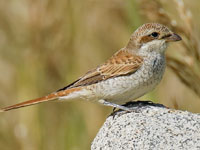
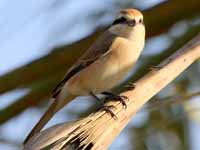
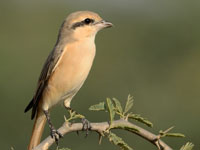
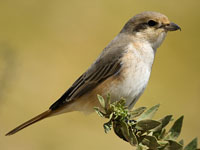
Shrike,_Lesser_Gray Lanius minor Found: Europe, Asia, Africa
The Lesser Gray Shrike has predominantly black, gray, and white plumage. Males have pink tinged underparts. A distiginguishing feature is the black forehead.
Image by: 1) Bernard_Dupont 2) Andy_Morffew. 3) Pim Stouten - South Africa 4) Daniel Bastaja 5) Vitaliy Khustochka - Ukraine 6) Nik_Borrow - Tanzania1) Juvenile 2) Female
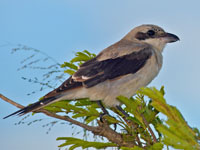
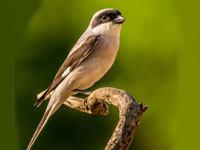
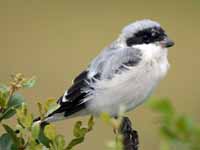
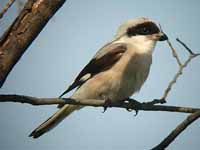
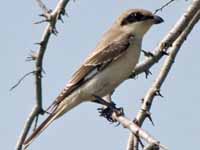
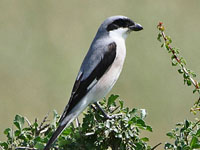
Shrike,_Loggerhead Lanius ludovicianus Found: North America
Similar to: Northern Mockingbird. Loggerhead Shrike has black eye-line; Northen Mockingbird has no eye-line.
Similar to: Northern Shrike. The Loggerhead Shrike has a wider eye band than does the Northern Shrike.
Image by: 1, 2) Dick Daniels - Florida 3, 4) Dick - North Carolina 5) Becky Matsubara - CaliforniaSimilar to: Northern Shrike. The Loggerhead Shrike has a wider eye band than does the Northern Shrike.
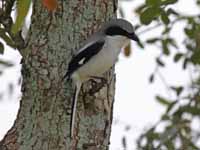


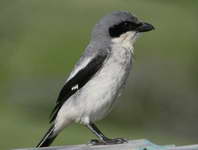
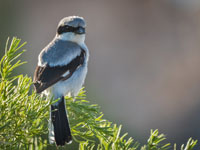
Shrike,_Long-tailed Lanius schach Found: Asia
Image by: 1) Lip_Kee - India 2) Munish_Jauhar 3) Alnus - Taiwan 4) Shantanu Kuveskar - India 5) Ansel.Ma
1) Juvenile
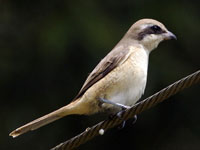
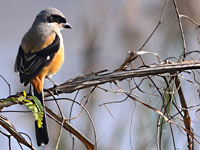

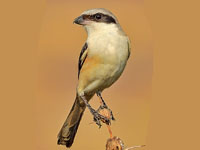
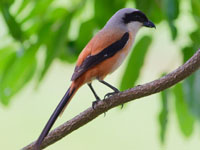
Shrike,_MacKinnon's Lanius mackinnoni Found: Africa
The MacKinnon's Shrike has grayish-black mantle, head; white supercilium, underparts; black wings, tail.
Image by: 1, 4) Nik_Borrow - Cameroon, Uganda 2) Francesco Veronesi - Uganda 3) Peter_Steward - Kenya 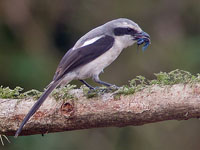
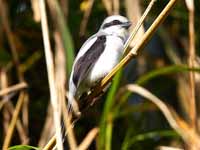
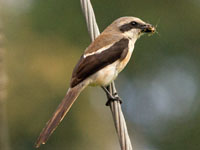
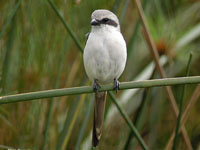
Shrike,_Masked Lanius nubicus Found: Europe, Asia, Africa
The male Masked Shrike has mainly black upperparts, crown, tail, wings; white patch on wings conspicuous in flight; white forehead; black eye-line; whitish underparts with orange flanks. Female upperparts are gray rather than black; white underparts with minimal orange on the flanks.
Image by: 1, 4) Durzan 2) Clauia Becker 3) Angie and Chris Pye - Cyprus
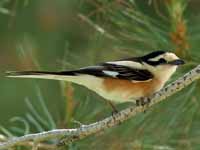
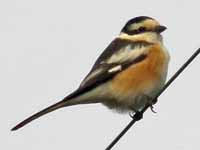
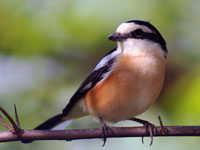
Shrike,_Northern also Great Gray Shrike also Northern Gray Shrike Lanius excubitor Found: North America, Europe, Asia
Similar to: Loggerhead Shrike. The Loggerhead Shrike has a wider eye band than does the Northern Shrike.
Similar to: Northern Mockingbird. Northern Shrike has black eye-line; Northen Mockingbird has no eye-line.
Image by: 1) Marek Szczepanek - Poland 2) Nik Borrow - Senegal 3) Ingrid_Taylar Trebol-a - SpainSimilar to: Northern Mockingbird. Northern Shrike has black eye-line; Northen Mockingbird has no eye-line.
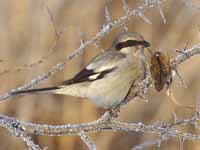
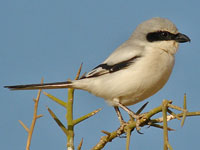
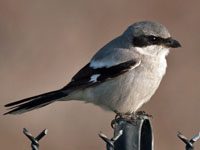
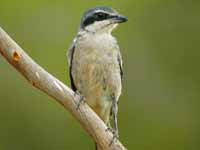
Shrike,_Red-backed Lanius collurio Found: Europe, Asia, Africa
The male Red-backed Shrike has reddish-brown back; gray crown, rump; black mask; pinkish to white underparts. Female has brown upperparts, mask; whitish underparts with barring on breast and flanks.
Image by: 1, 5) Arno Meintjes 2, 4) Frank Vassen 3) Imran_Shah - Pakistan
6) Antonios_Tsaknakis1) Juvenile 2, 3, 4) Female 5, 6, 7) Male
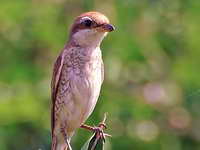
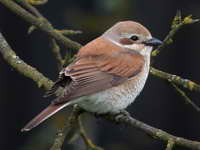
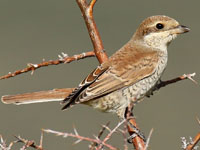
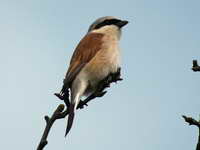
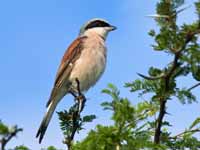
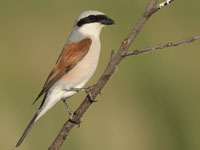
Shrike,_Red-tailed also Turkestan Shrike Lanius phoenicuroidesFound: Asia, Africa
The Red-tailed Shrike was formerly considered conspecific with the Isabelline Shrike and the Red-backed Shrike. The Red-tailed Shrike breeds in south Siberia and central Asia. It has sandy upperparts; white underparts; black mask; red tail.
Image by: 1, 2) Sergey Yeliseev - Kazakastan 3) Jrrobinantony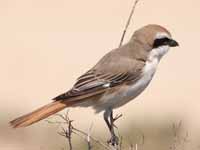
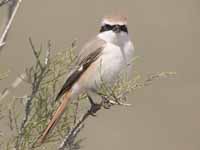
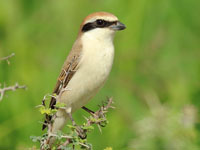
Shrike,_Southern_Gray Lanius meridionalis Found: Europe, Africa
Image by: 1) Cristiano Crolle - Monfrague, Spain 2) Anders Olsson - Oman 3) Juan Emilio 4) Frank_Vassen - Canary Islands

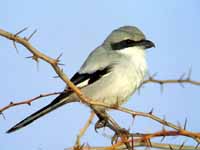
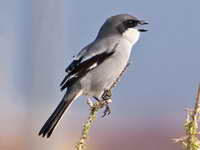
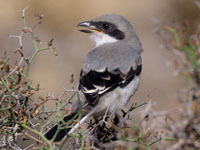
Shrike,_Souza's Lanius souzae Found: dry savannas of central Africa
The Souza's Shrike has gray crown, mantle; black mask; white wingbar; pale underparts.
Image by: 1) Ron Knight 2) Francesco Veronesi 3) Peter_Steward - Malawi 3) Nik_Borrow - Malawi
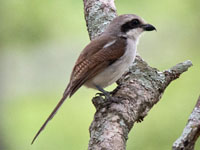
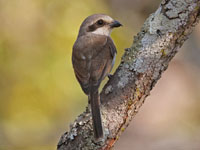
Shrike,_Tiger Lanius tigrinus Found: Asia, Indonesia, Malasi
The breeding Tiger Shrike has gray crown; nonbreeding has brown crown. It has reddish-brown back, shoulders and rump with blackish bars - creating a tiger-like pattern. White underparts with some barring on flanks.
Image by: 1) Johnny Wee - Singapore 2) Lip Kee - Singapore 3) Melvin Yap - Singapore 4) Kia Bo He1) Juvenile 2) Female
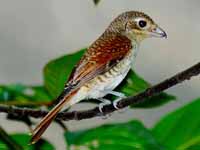
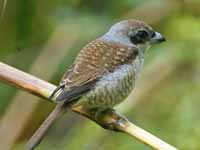

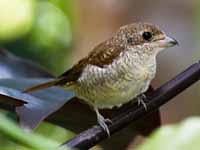
Shrike,_Woodchat Lanius senator Found: Europe, Africa
The male Woodchat has chestnut crown, nape upper-mantle; white scapulars, rump; black mask, most of tail; light underparts. Female similar, but duller.
Image by: 1) Causinho - Spain 2) Muchaxo 3, 4) Durzan 5) Agustin_Povedano1, 2) Female 3, 4, 5) Male
